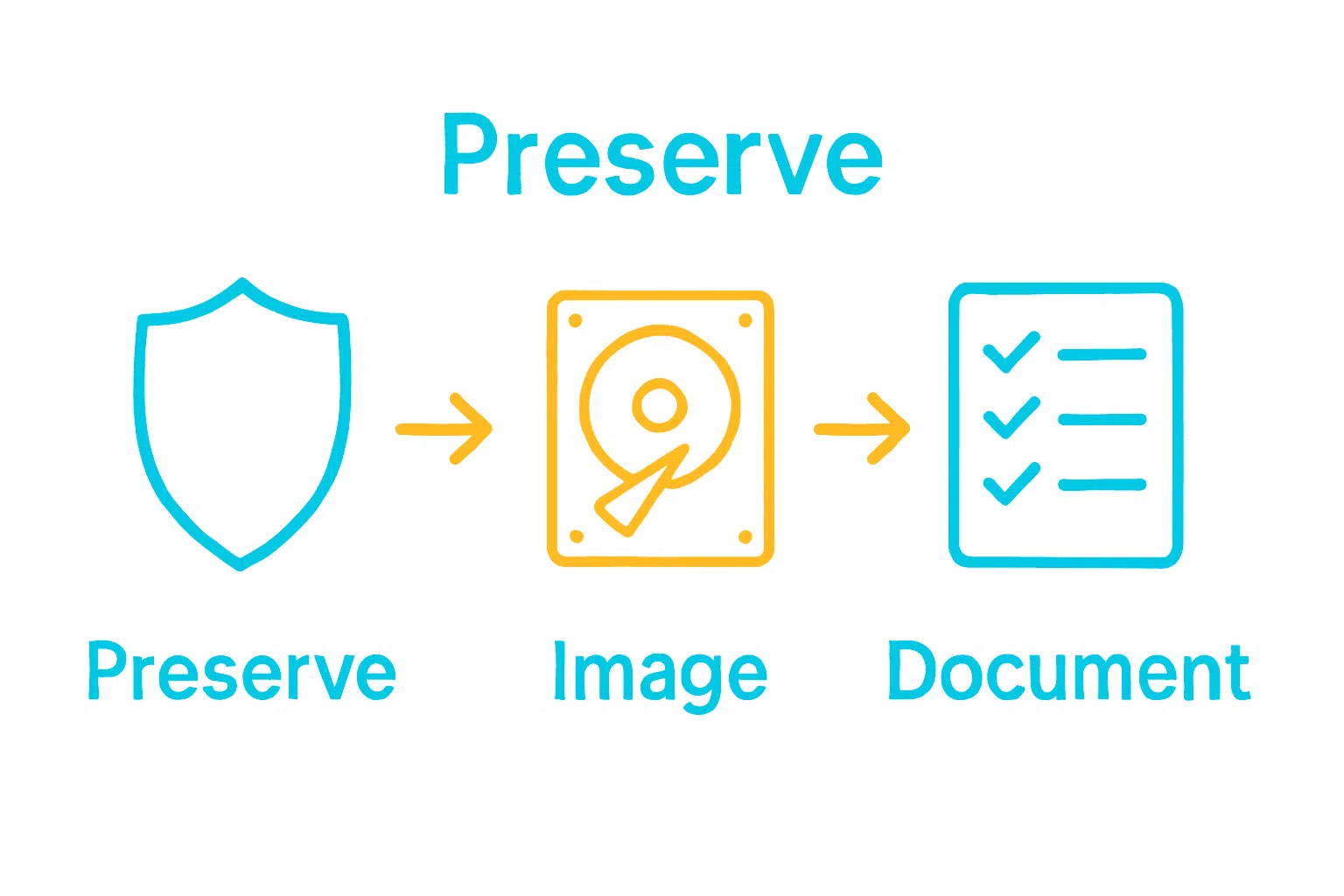Over 90 percent of legal cases involving digital devices rely on properly preserved and documented digital evidence. Precision and thoroughness are not just recommended, they are vital when the outcome could depend on the smallest detail. This step-by-step guide reveals how to secure digital evidence with proven forensic standards, ensuring that every action stands up to scrutiny in courtrooms and during technical analysis.
Table of Contents
- Step 1: Establish Evidence Preservation Protocols
- Step 2: Document and Assess Target Digital Devices
- Step 3: Create Forensic Images of All Media
- Step 4: Employ Specialised Recovery Tools and Techniques
- Step 5: Validate Recovered Data Against Original Evidence
- Step 6: Document Findings for Legal Admissibility
Quick Summary
| Key Point | Explanation |
|---|---|
| 1. Establish evidence preservation protocols | Create structured protocols that maintain the integrity and chain of custody for all digital evidence throughout the investigation process. |
| 2. Document device assessments thoroughly | Conduct detailed evaluations of target devices, recording their physical and operational states as a foundation for forensic analysis. |
| 3. Create verified forensic images | Generate duplicate copies of digital media while ensuring the original data remains unaltered, essential for legal admissibility. |
| 4. Employ specialised recovery tools efficiently | Select appropriate forensic tools that can extract and analyze data from varied digital platforms while ensuring legal soundness. |
| 5. Document findings for legal admissibility | Compile a comprehensive report detailing the forensic methodology and outcomes to support the findings in legal contexts. |
Step 1: Establish evidence preservation protocols
Establishing robust evidence preservation protocols represents the foundational step in ensuring the legal admissibility and integrity of digital forensic investigations. Your primary goal is to create a systematic approach that maintains the authenticity and chain of custody for all digital evidence.
According to the National Institute of Standards and Technology (NIST), preserving digital evidence requires meticulous documentation and handling procedures. The process begins with creating a comprehensive evidence collection strategy that includes:
- Documenting the initial state of digital devices
- Capturing bit-by-bit forensic images of storage media
- Generating cryptographic hash values to validate evidence integrity
- Maintaining detailed logs of all evidence handling procedures
The Digital Preservation Coalition recommends implementing write protection mechanisms during evidence capture to prevent any unintentional modifications. This critical step ensures that original data remains unaltered and forensically sound.
Professional Tip: Always work on forensic copies, never on original evidence. Create multiple verified copies to protect against potential data loss or corruption.
By establishing these rigorous preservation protocols, you create a legally defensible process that protects digital evidence from the moment of collection through subsequent analysis and potential courtroom presentation.
Step 2: Document and assess target digital devices
Documenting and assessing target digital devices marks a critical phase in the forensic data recovery process. Your objective is to conduct a comprehensive initial examination that captures the device’s current state, configuration, and potential evidence potential.
Research from ArXiv emphasizes the significance of developing a multi-platform process flow for extracting and documenting digital evidence. This involves creating a systematic approach to device assessment that ensures repeatable and legally defensible outcomes. Key steps include:
- Performing a visual inspection of the physical device
- Recording serial numbers, model information, and visible damage
- Documenting the device’s power state and operational condition
- Capturing screenshots of active applications and system settings
- Noting network connections and peripheral device attachments
According to the American Military University, ensuring the legal admissibility of digital evidence requires meticulous documentation that demonstrates the evidence is relevant, authentic, and lawfully obtained.
Professional Tip: Always photograph the device before any interactions to create an independent visual record of its original condition.
This detailed documentation serves as a critical foundation for subsequent forensic analysis, providing a comprehensive baseline that can withstand potential legal scrutiny and support the integrity of your investigation.

Step 3: Create forensic images of all media
Creating forensic images represents a crucial stage in digital evidence preservation where you will capture exact replicas of digital media without altering the original data. Your primary objective is to generate comprehensive bit-by-bit copies that retain every digital artifact and metadata element.
The National Institute of Standards and Technology (NIST) emphasizes the critical importance of creating forensic images that maintain the integrity and authenticity of digital evidence. This process involves using specialized forensic imaging tools to generate exact sector-level copies of storage media, ensuring that:
- Every bit of data is precisely duplicated
- Deleted files and hidden partitions are captured
- Metadata and system structures remain intact
- The original media remains completely unmodified
The Digital Preservation Coalition recommends using write-blocked forensic acquisition tools that prevent any potential modifications during the imaging process. This approach guarantees that the forensic image serves as a legally defensible and scientifically sound representation of the original digital media.
Professional Tip: Always generate multiple verified forensic images and store them on separate secure storage devices to prevent potential data loss.
Step by Step Digital Evidence Collection Guide can provide additional guidance on advanced forensic imaging techniques. By meticulously creating these forensic images, you establish a reliable foundation for subsequent detailed digital forensic analysis.
Step 4: Employ specialised recovery tools and techniques
Employing specialised recovery tools requires a strategic approach to extracting digital evidence while maintaining forensic integrity. Your goal is to select and implement the most appropriate forensic technologies that can recover critical data across various digital platforms and devices.
Wikipedia’s overview of MOBILedit Forensic highlights the importance of using comprehensive forensic tools capable of searching and extracting detailed information from multiple device types. These specialised tools enable forensic experts to:
- Extract comprehensive device data
- Recover deleted communications
- Analyse metadata and system logs
- Generate forensically sound reports
XRY software documentation emphasizes the critical nature of using integrated hardware and software solutions that support forensically validated data extraction processes. This approach ensures that recovered evidence remains admissible in legal proceedings.
Professional Tip: Always validate your forensic tools’ capabilities against specific device models before beginning evidence recovery.
7 Top Digital Forensics Techniques Every Legal Team Must Know can provide additional insights into selecting the most appropriate recovery methodologies for your specific investigation. By carefully selecting and implementing these specialised tools, you create a robust framework for comprehensive digital evidence recovery.
Step 5: Validate recovered data against original evidence
Validating recovered data is a critical forensic process that ensures the integrity and reliability of digital evidence. Your primary objective is to confirm that the extracted data precisely matches the original digital media without any unintentional modifications or corruption.
The National Institute of Standards and Technology (NIST) emphasizes the necessity of thorough documentation and verification processes. The validation procedure involves several meticulous steps:
- Generating cryptographic hash values for original and recovered data
- Comparing file system structures and metadata
- Verifying bit-level accuracy of data reproduction
- Documenting all verification processes
The Digital Preservation Coalition recommends using advanced forensic techniques like hash value comparisons and write blocking mechanisms to prevent data alteration during the validation process. This approach guarantees that recovered evidence maintains its original forensic integrity.
Professional Tip: Use multiple hash algorithms (MD5 and SHA256) to cross verify data authenticity and reduce potential verification errors.
Essential Digital Evidence Preservation Methods for 2025 can provide further insights into advanced validation techniques. By rigorously validating recovered data, you establish a solid foundation for legal and investigative processes.
Step 6: Document findings for legal admissibility
Documenting forensic findings is a critical process that transforms technical investigation results into legally admissible evidence. Your primary objective is to create a comprehensive report that transparently communicates the forensic investigation methodology and substantive discoveries.
The National Institute of Standards and Technology (NIST) emphasizes the importance of creating meticulous documentation that captures every aspect of the forensic investigation. This comprehensive documentation should include:
- Detailed chronological timeline of investigation steps
- Specific tools and methodologies employed
- Precise descriptions of data recovery techniques
- Comprehensive list of recovered digital artifacts
- Explanation of analytical processes and interpretations
The Digital Preservation Coalition recommends developing reports that demonstrate clear chains of evidence and maintain rigorous standards of authenticity. Your documentation must withstand potential legal scrutiny by providing transparent and reproducible investigative processes.
Professional Tip: Include screenshots and hash values as supplementary evidence to strengthen your forensic report’s credibility.
The Essential Guide to Digital Forensics in Litigation offers additional insights into creating robust legal documentation. By crafting a meticulously detailed report, you transform technical findings into compelling legal evidence that can effectively support judicial proceedings.
Secure Your Digital Evidence with Expert Forensic Data Recovery
Recovering critical digital evidence can be daunting when the preservation of data integrity and legal admissibility are at stake. This article highlights key challenges such as maintaining chain of custody, creating forensic images, and validating recovered data using advanced forensic techniques. If ensuring forensic soundness and transparent documentation are your priorities, professional support is essential.
At Computer Forensics Lab, our Forensic Data Recovery specialists combine cutting-edge technology with meticulous processes to safeguard your evidence from loss or contamination. With expertise in handling computing devices and mobile platforms, we help legal professionals and investigators achieve dependable results that stand up in court. Do not let fragile digital evidence jeopardise your case act now to collaborate with trusted Forensic Data Specialists who understand the critical importance of precision and reliability. Begin your journey towards reliable forensic recovery today by visiting Computer Forensics Lab and secure the strong foundation your investigation deserves.
Frequently Asked Questions
What is the first step in the forensic data recovery process?
Establishing evidence preservation protocols is the first step. Create a systematic approach to maintain the authenticity and chain of custody for all digital evidence, ensuring it remains legally admissible.
How should I document the state of a target digital device?
Document the initial state by performing a visual inspection and recording key details such as serial numbers, model information, and any visible damage. Take photographs before interacting with the device to maintain an independent visual record.
What does creating forensic images involve and why is it important?
Creating forensic images involves capturing exact bit-by-bit replicas of digital media without altering the original data. This is crucial for maintaining the integrity of the evidence, as these images provide a reliable basis for further analysis.
How can I ensure that recovered data matches the original evidence?
To validate recovered data, generate cryptographic hash values for both original and recovered data and compare them. This process confirms that the extracted data is identical to the original, ensuring its integrity for legal purposes.
What should be included in a forensic findings report for legal admissibility?
A comprehensive report should include a detailed timeline of investigation steps, specific methodologies used, and descriptions of the recovered digital artifacts. Ensure to document the entire analysis process clearly to withstand legal scrutiny.
How do I maintain the integrity of the evidence during recovery?
Use specialised tools designed to extract data without altering original evidence and implement write-blocking techniques. This helps to create a forensically sound environment for data recovery, preserving the authenticity of the evidence throughout the process.

